The OCZ Octane Review (512GB)
by Anand Lal Shimpi on November 23, 2011 12:00 PM ESTRandom Read/Write Speed
The four corners of SSD performance are as follows: random read, random write, sequential read and sequential write speed. Random accesses are generally small in size, while sequential accesses tend to be larger and thus we have the four Iometer tests we use in all of our reviews.
Our first test writes 4KB in a completely random pattern over an 8GB space of the drive to simulate the sort of random access that you'd see on an OS drive (even this is more stressful than a normal desktop user would see). I perform three concurrent IOs and run the test for 3 minutes. The results reported are in average MB/s over the entire time. We use both standard pseudo randomly generated data for each write as well as fully random data to show you both the maximum and minimum performance offered by SandForce based drives in these tests. The average performance of SF drives will likely be somewhere in between the two values for each drive you see in the graphs. For an understanding of why this matters, read our original SandForce article.
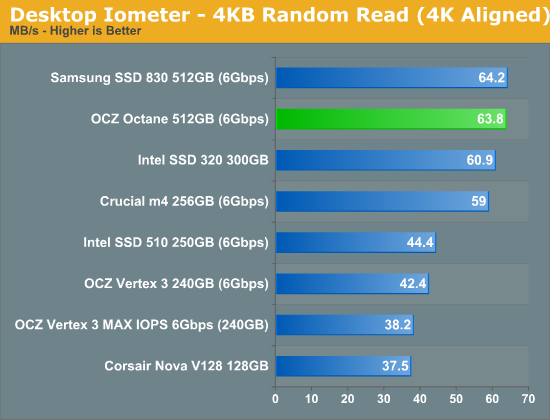
Random read performance is very good on the Octane, matching the Samsung SSD 830 and the Intel SSD 320. Random write performance is no where near as fast as the Samsung, Crucial or SF-2281 based drives, but as we've seen in the past this can be enough performance for a desktop workload.
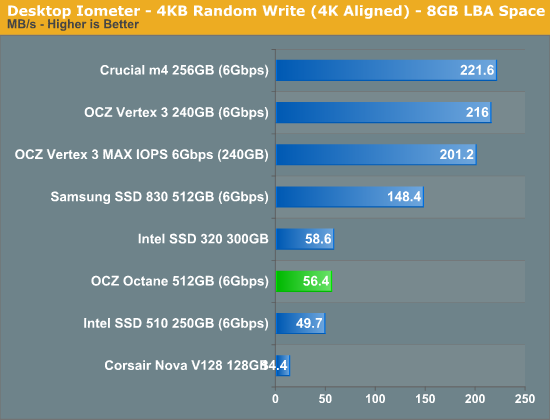
Many of you have asked for random write performance at higher queue depths. What I have below is our 4KB random write test performed at a queue depth of 32 instead of 3. While the vast majority of desktop usage models experience queue depths of 0 - 5, higher depths are possible in heavy I/O (and multi-user) workloads:
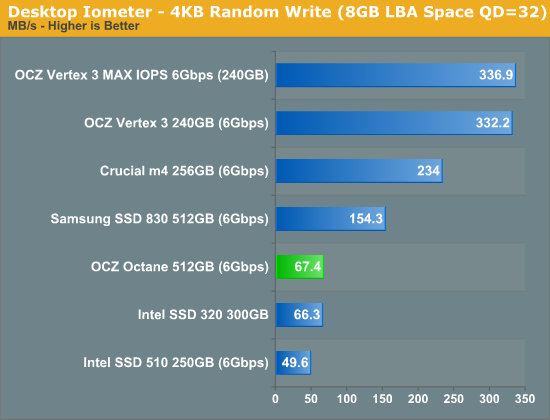
Random write performance at higher queue depths doesn't scale nearly as well as the SandForce based drives. This doesn't really matter for desktop users, but I am curious to see how OCZ will position Everest in the enterprise space against SandForce. Perhaps that's where OCZ will focus its SandForce efforts instead and leave the consumer market to Indilinx.
Sequential Read/Write Speed
To measure sequential performance I ran a 1 minute long 128KB sequential test over the entire span of the drive at a queue depth of 1. The results reported are in average MB/s over the entire test length.
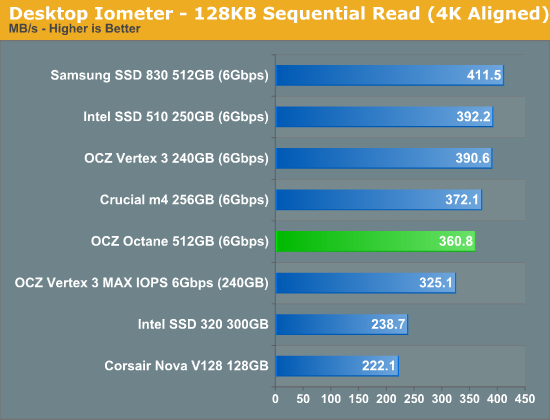
Sequential read and write performance is competitive, but not class leading. The Octane effectively performs like a Crucial m4 here, which isn't bad considering the m4 is a far more mature platform.
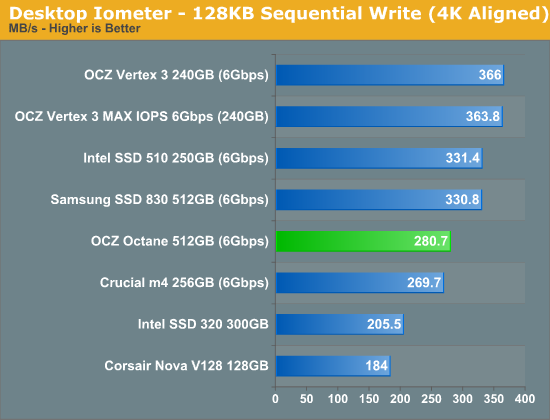










75 Comments
View All Comments
iwod - Wednesday, November 23, 2011 - link
So while hopefully pulling Seq Read Write Further until we reach the same point of the curve as Random Write, which should be fairly easy, SSD needs to Significantly improve Random ReadChloiber - Wednesday, November 23, 2011 - link
Anand - why don't you also test Random Read with a queue depth of 32? I agree that QD32 isn't as important as below-10s, but I don't quite understand why there is no QD32 Random Read but a QD32 Random Write?mino - Wednesday, November 23, 2011 - link
NAND 512GBUser Capacity 476GiB
I hope AT staff is aware that:
512GB (GigaByte) == 512*10^9 Bytes == 476*2^30 Bytes == 476 GiB (GibiByte)
If so, then what does "User capacity" mean in that table?
Provided a claimed 7% spare area, "User capacity" would be 512 GB*0.93 = 476.16 GB == 443.5 GiB.
In my humble opinion, the reality is such:
NAND Capacity is 512GiB
User Capacity is 476 GiB (== 512GB)
jwilliams4200 - Wednesday, November 23, 2011 - link
No, a 512GB drive should have 512GB of usable capacity. And the Octane apparently does (as do other 512GB SSDs).It also has 512GiB of flash memory on board.
512GiB / 512GB = 1024^3 / 1000^3 = 1.0737, which is about 7% reserved.
mino - Wednesday, November 23, 2011 - link
Yes, I suggest/expect the same thing.Now, please go and read the table at the beginning of the article which clearly states (as of now):
NAND 1TB 512GB 256GB 128GB
User Capacity 953GiB 476GiB 238GiB 119GiB
;)
jwilliams4200 - Wednesday, November 23, 2011 - link
Anand always gets his GiB / GB wrong. I don't think I have seen him get it entirely right in any article. So I tend to ignore his mistakes now. But you are correct that his NAND flash capacity row is wrong in this article. He wrote "GB" when he should have written "GiB".I was just responding to the line where you said the user capacity is 443.5 GiB (no, it is 476GiB, Anand at least got that right). Anyway, I think we are in agreement.
mino - Friday, November 25, 2011 - link
Yeah.What I do not understand why AT insists on using both GiB and GB in an article and making consistently fools of themselves by using it wrong..
If AT "named" all GiB values in that table as "GB", I would not really bother, as that is a common practice.
What always pisses me off is the smart-ass use of both *B and *iB in the same table while consistently getting it wrong one way or the other.
Why do I bother?
Because this sloppiness puts the important spare area claims into the "maybe, if they did not miscalculate" category...
Avenger762 - Wednesday, November 23, 2011 - link
I'm not sure if the OCZ name is really recovering. I have purchased many of the Vertex 30GB and Vertex 2 40GB drives for workstations in my organization as well as OCZ RAM. I had an ongoing fiasco on getting the RMA'd RAM back. In addition about 10% of the Vertex 30GB's have failed and 2 of the Vertex 2 40GB's that were purchased about 4 months ago just failed today. As soon as my supplier can get a contract with Kingston or SanDisk SSD's, I believe that I will switch over. OCZ was always good for my personal PC, but in large volumes for the organization that I work for, they fall way short.LB-ID - Wednesday, November 23, 2011 - link
...from OCZ's 3-series drives (Vertex, Agility, etc.). They were basically inoperable for a large chunk of their client base, and even after seven months now, although their current firmware is a vast improvement, issues still persist for some. Couple that with the dismissive (and sometimes worse) attitude displayed by their 'customer service', and you have a company with a badly-damaged reputation. I'll be steering clear of them for the foreseeable future, particularly with so many comparably-priced options with far better stability available from their competitors.Beenthere - Wednesday, November 23, 2011 - link
In all honesty OCZ as a company has never impressed me. I never found their tweaked RAM to be all that great. It was a niche product that eventually made them a lot of money when review sites hyped it but the performance gains were really more in benchmarks than in system performance.Then OCZ moved on to PSUs. As history has shown this has been a mixed bag for them too. Lots of QC and design issues from their suppliers didn't help. Then they bought PCPC to try and figure out how to produce quality PSUs. Today they still have a mixed bag of PSUs under the OCZ brand with only PCPCs stuff always be top quality.
Now OCZ is flooding the market with SSDs. Needless to say all SSD suppliers have had issues with the immature tech they have been dumping in the market for naive consumers to gobble up. There has been a pretty high price to pay for being naive and jumping on these half-baked SSDs, especially OCZ's.
It would appear that OCZ is trying to stay one step ahead of the competition with all sorts of variations in SSDs be it SandForce based, Revo or now Octane. This "shotgun approach" may work for sales but as we know, OCZ's SSD quality and compatibility resembles that of their RAM and PSUs... NOT very inspiring.
So the watch word is WAIT and let other folks be UNPAID Beta testers on these half-baked products - as Anand so rightly suggested.